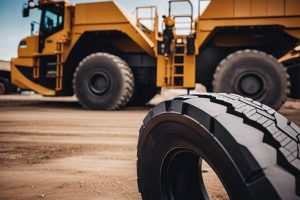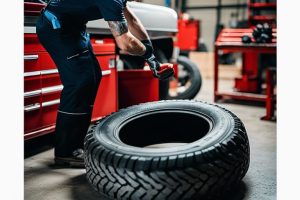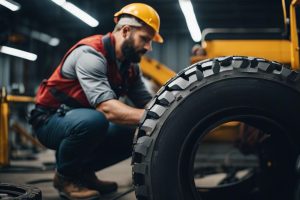Ensuring that Off-The-Road (OTR) tires are properly inflated is critical for both performance and safety. Wrong tire pressure can lead to premature wear, reduced fuel efficiency and even accidents. In this comprehensive guide we cover the What to do and what not to do of inflating OTR tires to help beginners navigate this necessary maintenance task with confidence. From recommended pressure levels to the tools required, follow these expert tips to keep your OTR tires in top condition and maximize their lifespan.
Key learning points:
- Correct inflation: Ensuring that OTR tires are inflated to the correct pressure is critical to maximizing tire performance and life.
- Use the right equipment: It is important to use a calibrated tire pressure gauge and a high-quality air compressor to accurately inflate OTR tires.
- Avoid excessive inflation: Overinflating OTR tires can lead to uneven wear, reduced traction and potential blowouts. Therefore, always follow the recommended tire pressure guidelines.
Preparation before inflation
The process of properly inflating OTR tires begins with adequate preparation before inflation. This crucial step ensures that the tires are ready for inflation and helps prevent potential hazards or accidents during inflation.
Safety tips
Before inflating OTR tires, it's important to prioritize safety. Always carry protective equipment such as gloves and safety glasses to prevent injury. Make sure the work area is clear of obstacles and bystanders before starting inflation. Be careful with the high-pressure air used to inflate the tires as it can cause serious damage if not handled properly. Observe the potential risks and taking the necessary precautions are the key to a safe tire inflation process.
Required tools and equipment
To properly inflate OTR tires, you will need some important tools and equipment. A reliable and accurate tire pressure gauge is important to ensure that the tires are inflated to the correct pressure. In addition, an air compressor with sufficient power to handle OTR tires is necessary for the inflation process.
Tips: Choose a tire pressure gauge specifically designed for OTR tires to ensure accuracy. It is also recommended to have a tire inflator with a built-in pressure regulator to prevent overinflation. Properly maintaining and calibrating your tools and equipment is critical to accurate and safe tire inflation.
Inflate OTR tires
If you have Off-The-Road (OTR) tires, knowing how to properly inflate them is critical to ensure safety and optimal performance. Proper tire pressure not only extends the life of your tires, but also improves fuel economy and overall vehicle handling. In this guide, we will take you step-by-step through the process of inflating OTR tires and discuss the key factors that influence proper tire inflation.
Step by step inflation process
When inflating OTR tires, it is essential to follow a systematic process to avoid over or under inflation. Below is an overview of the step-by-step inflation process:
| Step | Instructions |
| 1 | Check the tire pressure recommended by the manufacturer. |
| 2 | Use a reliable tire pressure gauge to measure the current pressure. |
| 3 | Add or release air as necessary to reach recommended pressure. |
| 4 | Recheck the pressure after inflation to ensure it is within the specified range. |
Factors that influence good inflation
Every OTR tire must be properly inflated to maintain safety and performance standards. Several factors can affect the proper inflation of OTR tires, including:
- Tire load: The weight the tire supports affects the required tension.
- Temperature changes: External temperatures can affect tire pressure.
- Terrain: Different terrain may require tire pressure adjustments for optimal performance.
On the other hand, understanding these factors is essential for maintaining your tires and ensuring safe operation. Knowing when and how to adjust tire pressure based on these conditions is critical to tire life and vehicle performance.
Inflate your OTR tires carefully and accurately, carefully following the manufacturer's guidelines. Remember that about or below inflation can lead to safety hazards, premature wear and reduced fuel efficiency. Keeping your OTR tires properly inflated is the key to maximizing their lifespan and maintaining optimal performance on and off-road.
Do's and don'ts when inflating OTR tires
Despite the importance of proper tire pressure, many car owners overlook this crucial aspect of maintenance. To help you navigate the do's and don'ts of properly inflating your OTR tires, we have set out some mandatory guidelines below. For a detailed step-by-step guide on how to inflate tires, please visit: Inflating car tires: a step-by-step guide.
Do's for optimal performance and longevity
The First step towards guaranteeing optimal performance and a long service life of your earth-moving tires check the tire pressure recommended by the manufacturer regularly. Proper tire pressure not only extends the life of the tires, but also improves fuel economy and the overall drivability of the vehicle. It is also crucial to use a reliable and accurate tire pressure gauge to measure pressure before and after inflation.
Another important dose for inflating OTR tires is: inflate the tires when they are cold. Heat development while driving can increase tire pressure, which can lead to inaccurate measurements. By inflating cold tires you can ensure that the pressure is at the correct level for safe and efficient operation.
What not to do to prevent damage and accidents
Not overinflating the tires above the recommended tire pressure as this can lead to uneven tire wear, reduced traction and an increased risk of tire blowouts. Prevent ignoring slow leaks or flat tires, as these can cause sudden tire failure and endanger road safety.
Each visible signs of damage such as cuts, bulges or excessive wear should not be ignored during the inflation process. Ignoring these issues can lead to tire failure and possible accidents in the workplace or while driving on the road.
Make sure OTR tires are properly inflated
Unlike many car tires, Off-the-Road (OTR) tires require special attention and care to ensure optimal performance and longevity. A crucial aspect of maintaining OTR tires is keeping them at the correct pressure. In this chapter, we discuss the importance of maintaining properly inflated OTR tires and provide essential tips to help you maintain your tires effectively.
Tips for regular checkups
Tips for staying properly inflated OTR tires this includes regularly checking tire pressure using a reliable meter. It is recommended to carry out this check at least once a week or before each use of the vehicle. Additionally, visually inspect the tires for signs of damage, such as cuts, cracks or bulges, which could affect tire pressure. Make sure the valve stems are in good condition and not leaking air.
- Regularly check the tire pressure
- Visually inspect injury
- Make sure the valve stems are present intact
With this routine maintenance you can identify any problems early and prevent possible tire failures. Please note, well inflated OTR tires not only improve vehicle performance, but also contribute to a safer driving experience. This proactive approach to maintenance can save you time and money in the long run by avoiding expensive repairs or replacements.
Adjusting inflation to different circumstances
Check your tire pressure OTR tires based on the specific operating conditions. For example, if you are carrying heavy loads, you may need to increase tire pressure to adequately support the weight. Alternatively, lowering tire pressure when driving on soft terrain such as mud or sand can improve traction and prevent the vehicle from becoming stuck.
To ensure optimal performance and To extend the life of your OTR tires, it is essential to adjust the tire pressure according to the operating conditions. Failure to do so can lead to premature wear, reduced traction and an increased risk of flat tires or blowouts. By following these guidelines you can maximize the life of your tires and maintain peak performance in a variety of driving conditions.
Last words
In closing, properly inflating OTR tires is crucial to ensuring safety, extending tire life, and maintaining optimal performance. By following the do's and don'ts in this beginner's guide, you can avoid common mistakes and keep your OTR tires in top shape. Remember to check tire pressure regularly, use a reliable pressure gauge and adhere to the manufacturer's guidelines. Investing time in proper tire maintenance will ultimately save you money and prevent expensive repairs or accidents in the future.
FAQ
Question: Why is it important to properly inflate OTR tires?
A: Properly inflating OTR (Off-the-Road) tires is critical for several reasons. It ensures optimal tire performance, improves fuel economy, promotes even tread wear and improves overall job site safety. Incorrect tire pressure can lead to tire damage, reduced traction and possible tire blowouts. So it is imperative to follow the manufacturer's recommendations.
Question: What are the dosages for inflating OTR tires?
A: Follow these instructions when inflating OTR tires:
– Use a reliable and accurate tire pressure gauge.
– Consult the manufacturer's guidelines for correct tire pressure.
– Inspect the valve stem for any damage or debris before inflating it.
– Inflate the tires when they are cool to get the most accurate pressure reading.
– Check the tire pressure again after inflation to ensure that the correct pressure is achieved.
Question: What should you not do when inflating OTR tires?
A: Here are some things not to pay attention to when inflating OTR tires:
– Do not over-inflate the tires as this can lead to reduced traction and a rougher ride.
– Avoid using an air compressor with an unknown or inaccurate pressure level.
– Do not ignore signs of damage or leakage during the inflation process.
– Never inflate a hot tire, as this may give an incorrect pressure value.
– Don't skip regular tire pressure checks, as good tire pressure is essential for tire life and performance.






